About possums
Somewhere… a possum
Even in the middle of the biggest cities, somewhere not too far away, there will be a possum. Ringtail or brushtail, possums are among the most versatile and adaptable of Australia’s marsupials; living much of their lives over our heads in the suburbs, and even under our roofs.

At night they emerge from their dens and dreys and crisscross their suburban territories in search of food—over rooftops, through treetops, and along powerlines and fences—avoiding the ground where they risk dog attack or being hit by a car.
While possums are usually wary of people and do us little harm, they can make nuisances of themselves by eating fruit and flowers from our gardens and, in the case of the brushtail possum, by taking up residence in the ceiling space of our homes.
By taking a few simple steps, like possum proofing your home (and even providing a nest box), brushtail possums can become a harmless, welcome sight; and living proof that people and wildlife can be good neighbours.
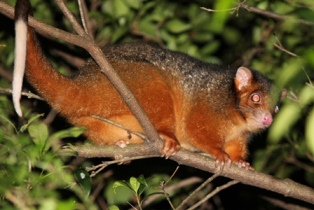
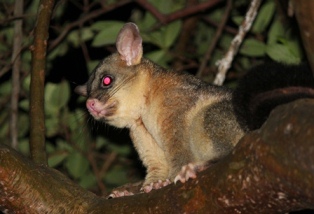
Understanding possums
The two commonly encountered species of possum are the common brushtail possum and the common ringtail possum. In wetter, higher altitude areas of south-east Queensland, a third species, the mountain brushtail possum occurs and can be distinguished from the common brushtail by its shorter rounded ears and, when found in rainforest it has a coat of black fur.
In the wet tropics several other species of ringtail possum can also be found including the Herbert River ringtail, the emblem of the Queensland Parks and Wildlife Service.
Possums each live within a home range. Home ranges of males and females overlap and common ringtail possums can form male–female bonds that last between breeding seasons. Common brushtail possums can form territories but usually rely on vocalisation and scent to establish den ownership and avoid any close and sometimes aggressive contact with neighbouring possums.
Availability of den sites is a critical factor limiting the number of possums in an area and, with few mature trees with hollow branches left in suburban areas, brushtail possums have adapted by moving into the ceilings of our homes.
Available dens are fully occupied by adult possums and a possum without a den will not survive. This means that as juvenile possums become independent and disperse, many will die from being unable to establish a home range. It also means that if a possum is removed from an area another one will soon fill the available den.
Ringtail possums nest in a ball of sticks known as a drey that is woven together in the branches of a tree. Ringtail possums will build a number of dreys within a home range so that if one is accidentally destroyed they will move to another. The immediate threat to the possum is harassment from crows and noisy miners if an occupied drey is destroyed during the day and the possum can’t find shelter.
Possums are usually solitary. Where two possums are seen together it is usually a mother and joey. Ringtail possums often have twins.
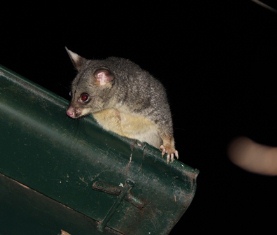
Is it a rat or possum in your roof?
In some cases possums are wrongly blamed for stealing fruit or inhabiting your ceiling, with introduced rats likely to be the real culprits. How you answer the following questions can help you to work out whether you are being visited by rats or possums.
What noise does it make?
If there’s something moving around in the ceiling it will make different sounds depending on its size, what it is doing and how it walks. Rats (weighing no more than a few hundred grams) tend to scurry when they move while brushtail possums (weighing in at up to five kilograms) will thump about in the roof even when they are walking slowly. Rats also need to keep their continually growing front teeth chisel-sharp and will gnaw loudly on anything they find (even carrying old bones into roof and wall cavities to maintain their teeth). If you hear noises in the wall cavity of your home, it is most likely that it will be a rat.
If there’s more than one animal in your roof they are likely to be fighting over a territory or mating. In either case the noise made will help you to guess the size of the animal. Rats and possums will both squeal when fighting (or mating) with the rat’s squeal being higher pitched.
A resident male brushtail possum will also make a loud throaty call to warn other males that are found within its home range (listen to the recording available on the species profile on this website).
Has it made a nest?

Brushtail possums may have a nest of leaves in your ceiling but will just as happily do without, or bed down on ceiling insulation. Rats usually build small nests in sheltered locations, often on the ground, and line them with shredded paper, rags or dry plant material. Ringtail possums create a ball of woven twigs within the canopy of a tree (sometimes only a few metres above the ground). In the wild, brushtail possums simply curl up in a sheltered cavity like a tree hollow, sometimes lining it with leaves.
Has it left behind any droppings?
Rats and possums typically have black pellet shaped droppings ranging in size from about seven millimetres in length for rats to more than 15 mm for brushtail possums (with ringtail possums somewhere in the middle). Where you find them will also be a clue as to who left them with rats droppings often being found scattered around a sheltered feeding or nest site. Possums droppings are more likely to be found under a tree where the animal has been feeding.
Keeping possums out of your roof
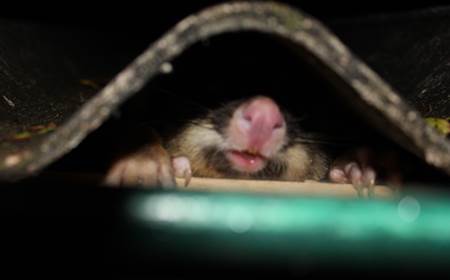
If a brushtail possum can get its head into a space then it can probably squeeze the rest of its body in too. Older homes often have openings into roof cavities that are big enough to let possums in.
Possum-proofing the roof of a house should be part of a home maintenance program but is often overlooked until the dull tread of possum feet overhead wakes you up in the middle of the night or a brown stain suddenly appears on the ceiling where a brushtail possum is using your roof space as a toilet.
Where are they getting in?
A simple way to find out whether an opening into the roof cavity of your home is being used by a possum is to loosely scrunch up a few sheets of newspaper and push them into any holes you find. If a possum is using it as an entry point into your roof it will push them out when it emerges at dusk. This process may have to be repeated after a possum has been removed and an entrance is sealed off as a possum may be using a number of entry points. Any vegetation overhanging the roof should also be trimmed back at the same time to remove access to other possible entry points.
Closing off any openings (and making sure the possum still isn’t inside)
After an opening has been found it can be sealed off, making sure the possum isn’t trapped inside. To avoid having to do the repair work at night it is possible to cover the entrance with a one-way exit that will allow the possum to leave but stop it from getting back in (this should be done in conjunction with erecting a nest box nearby to give the possum a chance to find alternative shelter). Cutting the bottom out of a heavy duty garbage bag and taping the bag over the exit point will allow the possum to push through it when it emerges but this will create a barrier that stops it from re-entering. If the holes are being covered in wire mesh the mesh can initially be attached on one side of the opening so that it can be pushed open by a possum as it leaves but springs back into place to stop the possum re-entering (the mesh can be held open with crumpled newspaper that will be pushed out when the possum leaves). Once certain that the possum is out of the roof, the other side of the mesh can be sealed off to block the entrance. Splashing strong smelling substances like disinfectant or spraying quassia chip solution (see ‘Keeping possums out of your fruit trees’) around the sealed off entrance will discourage a possum from trying to get back in.
Providing alternative accommodation
Brushtail possums will only survive if they have a den. Without one, they are exposed to a range of day-time threats including attacks from crows and other birds, and the risk of aggressive encounters with other possums when they try to invade den sites that are already occupied.
See the Possum box plan for information on how to build your own nest box.
Keeping possums out of your fruit trees and vegetable garden
Possums seem to know exactly when fruit and vegetables are ripe (and when you plan to pick them so that they can get in just ahead of you!). Being very agile and dexterous climbers, it can be difficult to stop a possum from reaching fruit. A few options to consider include:
- Using collars of galvanised metal sheeting around the trunks or branches of trees to stop possums climbing. This only works where the collar is wide enough to stop possums jumping over it. Trees will also need to be pruned back so they can’t be reached from the canopy of adjoining trees, fence lines etc.
- Enclose individual fruit in shade cloth bags or cover them in inverted plastic plant pots that have been split up one side and half the base so that they form ‘bells’ over the top of the fruit.
- Enclose small fruit trees in frames covered in light shade cloth (avoid using any netting that an animal will get entangled in).
- Plants can be sprayed with a solution made from quassia chips to deter brushtail possums. Quassia chips suppliers and recipes for sprays are available on the internet.
- In extreme cases, vegetable gardens can be enclosed in chicken wire.
To remove or attract possums
People value the wildlife living around them in different ways. One person may have nest boxes in their yard and a garden full of native trees for possums to feed from, while their neighbour may be cursing the endless nocturnal trundling of possums over their roof, wondering where they are all coming from. Even with different values, there’s one thing that everyone would agree on: life is much simpler when possums aren’t a problem. So, whether you love them or hate them, whatever you do needs to consider how it affects all of your neighbours (including the non-human ones).
Removing possums
Possums are protected wildlife and their removal can only be carried out by licensed commercial possum relocators (relocators can be found in the Yellow Pages under ‘Possum removal’). Having a possum removed is not a ‘quick fix’. If the vacated den site is not sealed off it will simply be reoccupied (relocators usually block off any access points then set a cage trap in the ceiling to remove the possum from the roof and release it outside). You may also want to put up a nest box to provide a new home for the possum. Ask your possum relocator to seal off all the entry points to your roof space and install a nest box while they are there.
Relocators must release possums within 25 metres of the point of capture to ensure that an animal is not released into another possum’s home range (possums are less likely to survive if they are released into a new area where they do not have access to a den or must compete with a neighbouring possum for den space).
Attracting possums
If you like possums you may want to attract them to your yard. If there are already trees that provide flowers and fruit there are probably possums already living there and all you need to do is keep an eye out for them. For brushtail possums, the limiting factor for whether they live in an area is whether there is a potential den site for them to occupy (and there isn’t another possum living close by). In these situations, erecting a possum nestbox is likely to attract a possum although it may be taken up by one of a number of animals that use hollows for nests such as lorikeets or even introduced birds like the common mynah. A nest box will also provide a better alternative if a brushtail possum is living in your ceiling or somewhere that you don’t want it to be.
Providing artificial food to encourage possums into an area is also unnecessary as it could encourage possums to converge on a common food source creating stress and leading to injuries as they compete for food.
Possum watching
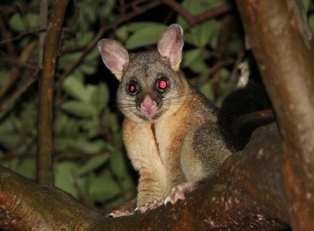
There’s something special about spotlighting a wild possum weaving its way along a branch in your own backyard. Staring down with its bulging eyes, it’s a reminder that the suburbs can still provide habitat for some of our wildlife.
Possums are creatures of habit and if you see or hear one in a tree or on your roof then it is likely to be somewhere in the vicinity at the same time the following night. Armed with a strong torch you can start to discover more about your neighbourhood possums. Some things to look for include:
- Individual possums may have unique markings or scars that distinguish them from others. As you become familiar with individuals you might be able to tell when new individuals move into an area and also watch young possums grow up.
- Over a number of nights follow a possum to see where it goes and what it does. Stake out possible dens and dreys at dusk to see if they are occupied. Look for signs that possums are around (droppings, half-eaten fruit, even tufts of fur).
Possum magic
With the holes in your ceiling blocked off, and maybe a nest box attached to a tree in the backyard, possums can become just another harmless wild animal that has stood its ground in the face of spreading human settlement and learnt to coexist with the people. And even if a few rose petals are ‘thieved’ or some fruit goes missing from a backyard tree, simple steps can be taken to make your neighbourhood possum ‘invisible’, or little more than an occasional reminder that you still have wild mammals living somewhere just outside. If a possum can learn to share our suburbs, maybe we can learn to coexist with them too.
